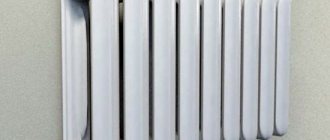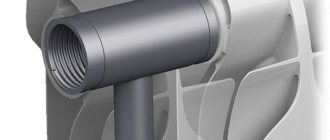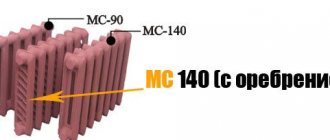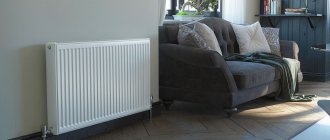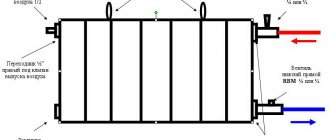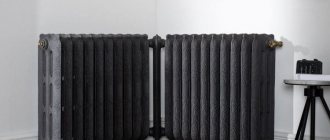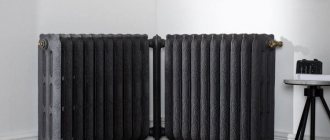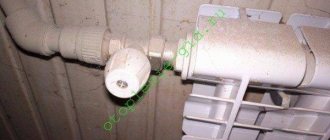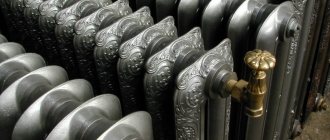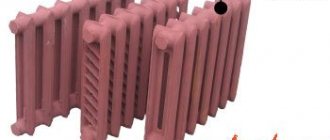Technical characteristics of MS 140 batteries
For the manufacture of this type of radiators, an entire GOST 8690–94 was developed at one time, regulating all parameters of the product. In accordance with it, 5 standard sizes of batteries were produced with center distances of 300, 400, 500, 600 and 800 mm. The table below shows cast iron heating radiators with technical characteristics of dimensions in accordance with GOST 8690.
Previously, all standard sizes of these devices could be seen not only in apartments, but also in industrial or administrative buildings. It is advisable to review the characteristics of the two most popular standard sizes: 300 and 500 mm, which are still in demand. Other modifications are now very rare, and they are made only to order.
The main technical characteristics of the cast iron radiator MS 140 with center distances of 300 and 500 mm are reflected in the following table.
Having studied all the characteristics, we can draw conclusions about the advantages and disadvantages of the heating devices in question. Their advantages are as follows:
- Durability. It is at least 30 years old.
- Heat dissipation. Despite its outdated design, the cast iron radiator MC 140 shows good thermal power values.
- Unpretentiousness. The gray cast iron from which the devices are made is not subject to corrosion and easily tolerates poor coolant with a high oxygen content.
- Low maintenance. It is not superfluous to flush the channels of the product once every 2 years, but if this is not done, then the MS 140 will continue to work safely. Only the heat transfer rate will begin to decrease.
- Inertia. It is both a plus and a minus of batteries. The advantage is that after the heating is turned off, the device continues to radiate heat into the room for a long time.
- Affordable price.
Now about the shortcomings, of which there are also many. The same inertia of the devices causes them to heat up for a long time and excludes the possibility of regulation using thermal heads. There are others:
- Large coolant capacity. This affects the rate of heating and cooling of the system, and also forces a lot of thermal energy to be spent on heating a large volume of water.
- The considerable weight of the products affects the installation of radiators. They are very difficult to mount on walls made of porous lightweight materials, which are very popular nowadays.
- Low operating pressure threshold. This makes it impossible to install it in high-rise building systems.
- Fragility. The wall-mounted cast iron radiator MC 140 500 is shock-resistant because it has thin walls. It cracks at the slightest freezing of water from frost.
- Unpresentable appearance compared to more modern analogues of cast iron batteries.
Qualities and characteristics
The described heating devices are designed to transfer thermal energy from the heating system to the premises of public, residential, industrial and other buildings. They are designed for coolant temperatures up to +130 degrees and operating (excess) pressure of the medium up to 0.9 MPa. Products are manufactured in accordance with GOST No. 31311/2005, as well as TU No. 4935/005/00288372/05.
Advantages of cast iron batteries
- High degree of corrosion resistance . This quality of cast iron is explained by the fact that during operation “dry rust” grows on its surface. It protects the material from corrosion.
- Cast iron has good wear resistance . Dirt and debris inside the system do not harm it.
- Excellent level of thermal inertia . Cast iron batteries, 60 minutes after turning off the heating, retain about 30 percent of the heat. For steel analogues, this parameter is only 15 percent.
- Very long service life . A high-quality device can last about 100 years. Manufacturers guarantee 15/25 years of trouble-free service.
The thermal photo shows that part of the battery is clogged with debris, which means it needs to be cleaned.
- Large cross-section of the internal space of the sections . Thanks to this, the batteries only need to be cleaned once every few years.
Note! Cast iron, due to its structure, cannot be a catalyst for electrochemical corrosion. In other words, the material does not conflict with steel and plastic heating pipes.
- The price of such heating devices is relatively small.
Radiator characteristics
Now a little about the technical properties of these products. They are slightly different for all MS brand models. As an example, we give data on MS-140-98 batteries.
| Parameter | Meaning |
| Manufacturer country | Russia Ukraine |
| Coolant temperature, maximum | +130 degrees Celsius |
| Working pressure, maximum | 9 bar |
| Pressure (testing) | 15 bar |
| Battery Type | sectional |
| Number of channels in one section | 2 |
| Coolant volume in one section | 1.35 liters |
| Thermal output of one section | 175 W |
| Mass of one element | 6.2 kg |
| Width of one section | 98 mm |
| Nipple hole section | 5/4 inch |
| Material of gaskets between sections | heat resistant rubber type |
| Material of plugs and sections | gray cast iron SCh/10 (according to State Standard No. 1412) |
| Nipple material | malleable cast iron KCh/30/6F (according to State Standard No. 1215) or steel 08/KP, 08/PS (according to State Standard No. 1050) |
| Nipple hole thread | G-1 at 1/4" |
Note! The instructions say that due to the thinness of the walls of the radiator elements, it is strictly forbidden to throw heating devices. Due to shocks during transportation, the devices may have loose nipple connections.
Based on this, before starting the heating system, it is necessary to carry out pressure testing (hydraulic testing) of the batteries yourself. If they leak anywhere, the nipples will need to be tightened in those places.
Pass-through plug.
Radiators are always equipped with two plugs (through) with a right-hand thread and two plugs (blind) with a left-hand thread, half an inch. Upon special order, the configuration can be changed.
Recommendations for selection and installation
The selection of this type of battery comes down to determining the required number of sections for heating a particular room and the appropriate standard size. To do this, you should know the required thermal power or approximately calculate it by quadrature, and take the heating radiators with some margin. If we take as a basis that for each m2 of area you need 100 W of thermal energy, then for a room of 10 m2 you will need 1 kW of heat, and sections of the MS device 140 500 - 1000 / 160 = 6.25, 7 pieces are taken.
For northern regions, an increasing coefficient of 1.5 to 2 must be applied to the value of thermal power, and for southern regions, a decreasing index of 0.7 must be applied.
Radiators are installed to an external wall in accordance with the diagram.
To fasten MC 140 batteries, 2 types of brackets are used: steel and cast iron.
There are paired brackets welded with a strip, which are best used when mounting on a wall made of porous materials. They can be attached to the surface at several points.
Advantages
- An unattainably long service life - this equipment lasts for 50 years;
- Large internal spaces, which gives:
- slow pollution - important for areas in apartment buildings, heated by old thermal power plants with dirty coolant;
- high inertness - important for private houses with solid fuel boilers, where there is no need to add firewood at night;
- low hydraulic resistance - required for gravity systems (operating without electricity);
Among the disadvantages are large size and weight, roughness of the surface, the need for painting, as well as low operating pressure (which limits applicability in buildings of no more than 15-22 storeys).
Calculation of the number of sections
Accurately determining the number of sections in a heating battery is a long process. You need to take into account the region, the material of the walls, what kind of windows and doors there are, how many windows are in the room, what their area is, whether the room below is warm or cold, etc. If you need an exact calculation method, look here, but you can roughly calculate based on the area of the room. It is believed that on average 100 W of heat is required to heat 1 m2 of area. Knowing the area of your room, determine how much heat will be needed: multiply the area by 100 W. Then divide by the thermal power of the selected radiator model.
For example, in a room of 12 m2 we will install MS-140M-500-0.9 from the Bryansk plant. Thermal power of the section is 160 W. Calculation:
- Total heat required is 12m2 * 100 W = 1200 W
- How many sections are needed 1200 W / 160 W = 7.5 pcs. We round (always up - it’s better if it’s warmer) and we get 8 pieces.
Characteristics and Features
The secret of their popularity is simple: in our country, the coolant in centralized heating networks is such that it even dissolves or erases metals. In addition to a huge amount of dissolved chemical elements, it contains sand, particles of rust that have fallen off pipes and radiators, “tears” from welding, bolts forgotten during repairs and a lot of other things that are unknown how they got inside. The only alloy that doesn’t care about all this is cast iron. Stainless steel also does this well, but one can only guess how much such a battery will cost.
MS-140 - an undying classic
And another secret of the MS-140’s popularity is its low price. It has significant differences between different manufacturers, but the approximate cost of one section is about $5 (retail).
Advantages and disadvantages of cast iron radiators
It is clear that a product that has not left the market for many decades has some unique properties. The advantages of cast iron batteries include:
- Low chemical activity, which ensures long service life in our networks. Officially, the warranty period is from 10 to 30 years, and the service life is 50 years or more.
- Low hydraulic resistance. Only radiators of this type can be installed in systems with natural circulation (some also use aluminum and steel tubular ones).
- High temperature of the working environment. No other radiator can withstand temperatures above +130oC. Most of them have a maximum limit of +110oC.
- Low price.
- High heat dissipation. For all other cast iron radiators, this characteristic is in the “disadvantages” section. Only MS-140 and MS-90 have a thermal power of one section comparable to aluminum and bimetallic ones. For MS-140, heat transfer is 160-185 W (depending on the manufacturer), for MS 90 - 130 W.
- They do not corrode when the coolant is drained.
MS-140 and MS-90 - difference in section depth
Some properties are a plus under some circumstances, and a minus under others:
- Large thermal inertia. It may take an hour or more until the MS-140 section warms up. And all this time the room does not heat up. But on the other hand, this is good if the heating is turned off, or a conventional solid fuel boiler is used in the system: the heat accumulated by the walls and water maintains the temperature in the room for a long time.
- Large cross-section of channels and collectors. On the one hand, even a bad and dirty coolant will not be able to clog them in just a few years. Therefore, cleaning and washing can be carried out periodically. But due to the large cross-section, more than a liter of coolant “fits” in one section. And it needs to be “driven” through the system and heated, which means extra costs for equipment (a more powerful pump and boiler) and fuel.
“Pure” disadvantages are also present:
- Heavy weight. The weight of one section with an axial distance of 500 mm is from 6 kg to 7.12 kg. And since you usually need from 6 to 14 pieces per room, you can calculate what the mass will be. And you will have to wear it, and also hang it on the wall. This is another drawback: difficult installation. And all because of the same weight.
- Fragility and low working pressure. Not the most pleasant characteristics. Despite their massive size, cast iron products must be handled with care: they may burst upon impact. The same fragility leads to not the highest operating pressure: 9 atm. Pressure testing - 15-16 atm.
- The need for regular coloring. All sections come only primed. They will need to be painted often: once every year or two.
Thermal inertia is not always a bad thing...
Application area
As you can see, there are more than serious advantages, but there are also disadvantages. If we summarize everything, we can determine the scope of their use:
- Networks with very low coolant quality (Ph above 9) and a large number of abrasive particles (without mud traps and filters).
- In individual heating when using solid fuel boilers without automation.
- In networks with natural circulation.

